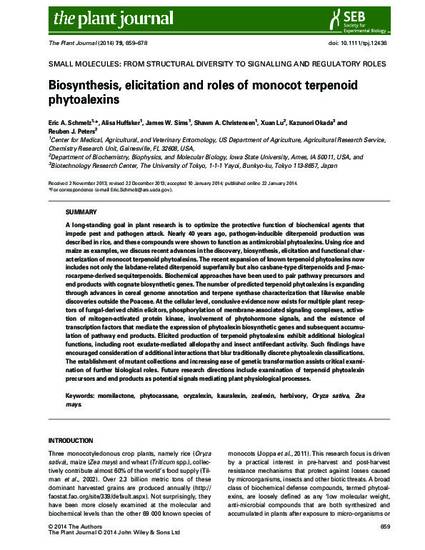
A long-standing goal in plant research is to optimize the protective function of biochemical agents that impede pest and pathogen attack. Nearly 40 years ago, pathogen-inducible diterpenoid production was described in rice, and these compounds were shown to function as antimicrobial phytoalexins. Using rice and maize as examples, we discuss recent advances in the discovery, biosynthesis, elicitation and functional characterization of monocot terpenoid phytoalexins. The recent expansion of known terpenoid phytoalexins now includes not only the labdane-related diterpenoid superfamily but also casbane-type diterpenoids and β-macrocarpene-derived sequiterpenoids. Biochemical approaches have been used to pair pathway precursors and end products with cognate biosynthetic genes. The number of predicted terpenoid phytoalexins is expanding through advances in cereal genome annotation and terpene synthase characterization that likewise enable discoveries outside the Poaceae. At the cellular level, conclusive evidence now exists for multiple plant receptors of fungal-derived chitin elicitors, phosphorylation of membrane-associated signaling complexes, activation of mitogen-activated protein kinase, involvement of phytohormone signals, and the existence of transcription factors that mediate the expression of phytoalexin biosynthetic genes and subsequent accumulation of pathway end products. Elicited production of terpenoid phytoalexins exhibit additional biological functions, including root exudate-mediated allelopathy and insect antifeedant activity. Such findings have encouraged consideration of additional interactions that blur traditionally discrete phytoalexin classifications. The establishment of mutant collections and increasing ease of genetic transformation assists critical examination of further biological roles. Future research directions include examination of terpenoid phytoalexin precursors and end products as potential signals mediating plant physiological processes.
Available at: http://works.bepress.com/reuben_peters/28/

This article is published as Schmelz, E. A., Huffaker, A., Sims, J. W., Christensen, S. A., Lu, X., Okada, K. and Peters, R. J. (2014), Biosynthesis, elicitation and roles of monocot terpenoid phytoalexins. Plant J, 79: 659–678. doi:10.1111/tpj.12436.